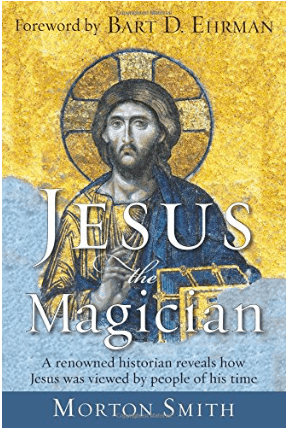Of the hundreds of books that are written in biblical scholarship every year, few make a long term impact and have an extended shelf life. Very few indeed deserve to be read and reread thirty-five years after their original appearance. Morton Smith’s Jesus the Magician is one of them, a twentieth-century classic, uncannily smart, incredibly learned, and yet accessible to laypersons as well as scholars, a book deserving a spot on the bookshelf of everyone interested in Jesus of Nazareth and the history of religion in antiquity.
–Bart Ehrman, Preface to the 2014 reprint of Jesus the Magician

In 1978 Morton Smith published a popular trade book titled Jesus the Magician (Harper & Row, San Francisco). To call it “controversial” is an understatement. Credit goes to legendary Harper editor John Louden for his encouraging and courageous efforts to provide the public with the best of such scholarship. [1]John shepherded another controversial book of mine, co-authored with Arthur Droge, to see the light of day, namely A Noble Death: Suicide and Martyrdom Among Christians and Jews in Antiquity, Harper … Continue reading
In the October 26, 1978 issue of the New York Review of Books, Frank Kermode offered a scathing review of Morton Smith’s book titled “The Quest for the Magical Jesus.” Smith of course responded and Kermode replied to him. The exchange is “classic Smith” and worth a careful reading. You can access it on-line here.
Thirty-five years after its initial publication a new edition came out with a forward by Bart Ehrman, see his Blog post “Jesus the Magician.” [2]This is a Members Only Blog but I urge ALL my readers to subscribe. There is nothing out there better in the field of Christian Origins–unless it is my TaborBlog 🙂 The cost is minimal and … Continue reading
I want to commend to my readers Morton Smith’s classic volume–either for reading or re-reading, as the case may be. Much like Schweitzer, whom I consider my literary “mentor,” in whose shadow I can not even stand, and a handful of other books on Jesus, this one never grows old. My colleagues are hopelessly divided on classifying and labeling the “historical figure of Jesus,” as E. P. Sanders puts it. Was he a failed Messiah, an Apocalyptic Prophet, an itinerant Stoic/Cynic philosopher, a Charismatic Rabbi, an illiterate Galilean peasant, or a nationalistic Zealot–or some combination of all of these? What most of these categorical portrayals fail to take into account is that Smith’s use of the figure of the “Magician” in late Antiquity is applicable to all of these sub-categories. In other words, the ancient Mediterranean world, whether one is talking about Jewish or non-Jewish religious figures and movements, is thoroughly Hellenized from stem to stern.
As the “other” Smith, Jonathan Z., used to say to his classes as we delved into letters like 1 Coninthians, “Don’t assume if you time-traveled back to an early gathering of Paul’s “Christ Mystics” you would understand a damned thing about what was going on ritually.” This was not a normal “Church Service,” or Rabbinic Talmudic academy, as things eventually developed liturgically by the 4th century CE. What we have today, even with the “most liturgical” of Christian or Jewish traditions, East and West, is a domesticated normalized version of the magical mystery tour we now call “early Christianity.”
Most important, all of these forms of Jewish expression in the late 2nd Temple period need to be set in their wider astral mystical context of Hellenistic Mediterranean religions more generally. Apotheosis is the only game in town. After all, “these things were not done in a corner.” To imagine the “crazy stuff” only came later with the so-called “Gnostics” reflects not only a category mistake, but an inexcusable ignorance of the wider world of Hellenistic religions–not as background to early Christianity but as its base and foundation. Here I refer my earnest readers to Jonathan Z. Smith’s incomparable survey in the Encyclopedia Britannica “Hellenistic Religions.” Run, don’t walk to read this one.









Comments are closed.